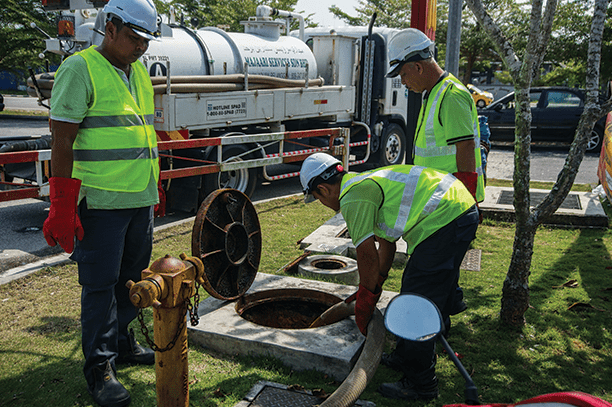In areas not connected to municipal water systems, commercial and residential properties treat domestic wastewater with various types of septic systems. A septic system’s design, size, and functioning can vary widely, from within your neighborhood to across the state, due to a combination of factors. These factors include soil type, household size, site slope, lot size, weather conditions, proximity to sensitive water bodies, or even local regulations.
In this blog post, we’ll explore the importance of proper septic system design, installation, and maintenance and how these factors contribute to the functionality and longevity of your septic system.
The Significance of Proper Septic System Design
Leading septic installation companies in Wilsonville reveal that proper septic system design is more than just laying down tanks and pipes. It involves careful planning and consideration to ensure your system functions efficiently and safely. A well-designed septic system can prevent issues like backups, leaks, and groundwater contamination, saving you time, money, and headaches down the road.
What Are the Different Types of Septic Systems?
Top septic system design experts in Molalla reveal that five different types of septic systems(with different installation methods), including,
1. Conventional Septic Systems
Traditional septic systems consist of a tank and a gravel drainfield. Wastewater and sewage flow through pipes from the property to the tank and then to the leach field. The tank then breaks down the wastewater while microbes in the surrounding soil treat the water as it flows toward the drainfield.
2. Chamber Systems
A chamber septic system is pretty similar to a traditional septic system. However, the pipes release the water into separate “chambers” of soil rather than gravel.
3. Aerobic Septic Systems
An aerobic advanced septic system uses a high-powered method of treating wastewater that allows for a smaller leach field. Leading septic design experts in Newberg reveal that added oxygen aids in bacterial treatment, making these variants a good choice for properties with high water tables or poor soil.
4. Drip Distribution
A drip distribution advanced treatment system releases sewage into the soil one drop at a time. Another septic tank controls how quickly the water drips and receives treatment.
5. Mound Septic Systems
In a mound septic system, a unique pump releases sewage and wastewater into a mound of sand near the property.
Mound septic variants require extra care and maintenance, but they can be extremely helpful in locations with low soil levels.
Steps for Installing a Septic System
1. Site Prep
First, you evaluate the concerned site’s size, water table, soil type, etc., to decide which septic system will work best for you.
Leading septic system design experts at Wilsonville reveal that this may require a PERC test to evaluate proper soil absorption rates. Contact your county health department for more information regarding testing requirements in your area.
2. Health Approval
Most states, including Newberg, Sherwood, Wilsonville, and Molalla, have specific guidelines for septic system installation, as, naturally, sewage could have a large impact on public health and safety. It’s imperative to obtain the required permits and licenses before proceeding with the procedure.
3. Excavation
Once you have received the necessary approval from the correct regulatory authorities, you may begin excavating the site for system installation.
Top septic system design professionals in Sherwood reveal that excavation involves a lot of measuring and drilling so that you can get the correct pipe-to-distance ratio. It goes without saying, but you need to dig a hole large enough to fit the tank comfortably.
4. Installation
Leading septic system design experts in Newberg advise against proceeding with installation without proper insight. That is, don’t just begin aimlessly digging holes and placing pipes. Call a professional septic system company like American On-Site Septic for advice and assistance.
5. Final Inspection
Having a professional like American On-Site Septic inspect your work once it is completed is always a good idea. It ensures that everything is up to safety standards and you won’t encounter any unexpected issues.
6. Coverup
Lastly, you should cover everything back up, clean it up thoroughly, and enjoy your money-saving handiwork!
Additional Tips for Septic System Maintenance
Top septic system design contractors in Wilsonville state that while it’s crucial to install your septic system correctly, it is equally important that you take proper care of it. Routine maintenance extends the system’s lifespan, saving you money on an early replacement. Some quick tips include,
1. Schedule routine maintenance and cleaning
Professional septic system care and upkeep is the key to preventing minor issues from turning into huge problems. You should schedule a professional septic consultation annually and a septic tank pumping every three to five years (depending on the tank capacity) by a credible provider like American On-Site Septic.
2. Be careful what you flush
Top septic design experts at Sherwood believe in the simple mantra: If it isn’t toilet paper, don’t flush it. Paper towels, napkins, diapers, baby wipes, and feminine products belong in the trash, not in your toilet. Take care, as these foreign matters can cause septic pipes to clog and burst.
3. Keep your eyes and ears open
Inspect your septic system to ensure everything is running smoothly. If you notice anything unusual, call a septic design professional like American On-Site Septic as soon as possible.
4. Take care of the drainfield
Leading septic design specialists in Molalla reveal that drainfields don’t function well under heavy foot traffic or near trees. You should keep the area clear for maximum functionality.
Final Takeaway
If you’re seeking an experienced, reliable, and affordable septic system service in Newberg, Sherwood, Molalla, Wilsonville, and nearby areas, look no further than American On-Site Septic. From septic installation and pumping to septic maintenance, we want to be your trusted go-to source for all your septic-related needs. Our dedicated team of professionals will come and inspect your plot, help you select the perfect right location for your septic system, and educate you on one of the top-quality septic system brands.
At American On-Site Septic, we understand that the last thing our customers want to deal with is a faulty, worn-out, or improperly installed septic system. That’s why we use only the best septic system components for our clients– whether for a complete installation or if you need a septic system repair.
Contact us at 503-822-7903 to schedule an appointment with our team today.






